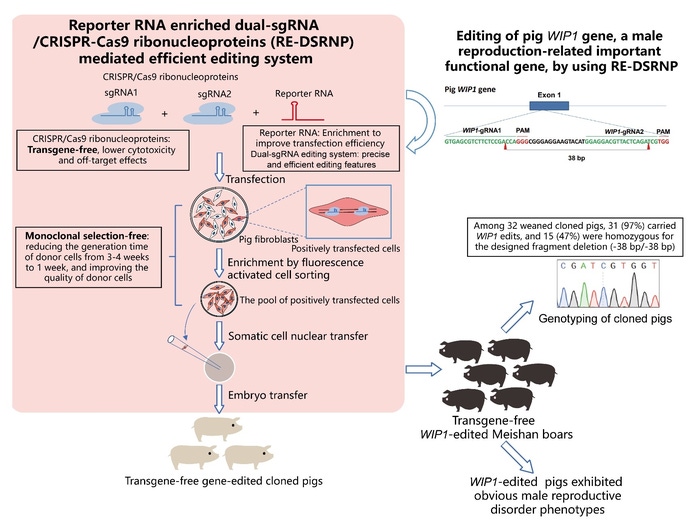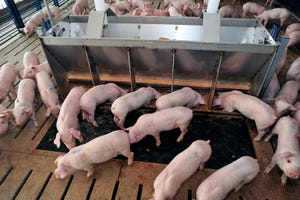Researchers in China use RE-DSRNP method to target WIP1 gene
Among 32 weaned cloned pigs, 97% carried WIP1 edits and 47% were homozygous for the designed fragment deletion, and no off-target event was detected.
March 25, 2022

Gene-edited pigs have important value in both agricultural and biomedical applications. However, there are still some areas that need to be improved in the process of generation of gene-edited pigs:
It is difficult to quickly obtain a large number of pig individuals with the same genotype.
Plasmid DNAs may be randomly integrated into the genome of the target cells.
The monoclonal selection process may reduce the quality of donor cells.
Recently, researchers from the Institute of Animal Sciences and the Agricultural Genomics Institute at Shenzhen of Chinese Academy Agricultural Sciences published a research paper entitled "A transgene-free method for rapid and efficient generation of precisely edited pigs without monoclonal selection" in Science China Life Sciences. They developed an efficient editing system named reporter RNA enriched dual-sgRNA/CRISPR-Cas9 ribonucleoproteins (RE-DSRNP) for the rapid generation of transgene-free gene-edited cloned pigs, and applied this RE-DSRNP method to establish a porcine model of male reproductive disorder by editing WIP1 gene.
The researchers used dual-sgRNA to improve the editing accuracy and efficiency; and used the CRISPR-Cas9 ribonucleoproteins (RNP) editing system for transgene-free editing, which successfully avoided the risk of plasmid DNA random integration, and with low off-target effect, low toxicity. They also combined the reporter RNA enrichment system with DSRNP, which eliminated the process of monoclonal cell selection on the basis of further improved editing efficiency, thereby shortening the culture time of donor cells from three to four weeks for one week, and significantly reducing the proportion of donor cells with apoptosis and chromosomal aneuploidy.
In order to verify the application of RE-DSRNP in the establishment of gene-edited cloned pigs, the researchers used the RE-DSRNP system to target the WIP1 gene in Meishan pig, a local pig breed in China known for its high reproductive performance. The results showed that: among 32 weaned cloned pigs, 31 (97%) carried WIP1 edits, and 15 (47%) were homozygous for the designed fragment deletion (-38 bp/-38 bp), and no off-target event was detected. The WIP1-edited pigs exhibited male reproductive disorders. Breeding boars play a pivotal role in pig breeding and commercial production, and have a decisive impact on sow fertility. In this paper, the WIP1 gene-edited pig model was established for the first time, which is of great significance for the in-depth study of the male reproductive mechanism.
Somatic cell nuclear transfer is the mainstream technology to generate gene-edited animals for animal breeding and medical model development. The RE-DSRNP system developed in this paper will significantly reduce off-target and unexpected effects, greatly improve efficiency and shorten the time. It is expected to promote the development of biological breeding and medical models of pigs and other animals, and has broad application prospects. RE-DSRNP's strong editing performance in a large animal and its marked reduction in required time for producing SCNT donor cells support its application prospects for rapidly generating populations of transgene-free cloned animals.
Source: Science China Press, which is solely responsible for the information provided, and wholly owns the information. Informa Business Media and all its subsidiaries are not responsible for any of the content contained in this information asset.
You May Also Like



